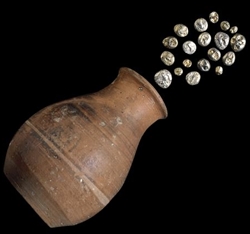 And the first coin ever minted was… read on to find out!
And the first coin ever minted was… read on to find out!
Today, you can’t trade if you don’t have money. Long ago, it was the other way around: you didn’t need money if there was no trade.
That is why the first “true” coins appeared in the areas where different groups of people converged, laden with diverse goods: they needed a way to trade those goods, a way that was a bit more sophisticated than the direct pottery-for-maize (or something similar) type of barter.
Since they also needed the materials and the skills to make “true”, minted coins, traders had to make do with shells or gold bars and similar currency until the Iron Age revolutionised the world around 600-700 BC. Soon afterwards, coins started popping up in places with lively trading in the eastern Mediterranean basin (Anatolia and Greece), from where they spread over surrounding areas. At about the same time, coins were independently invented in China and a little later in India.
The first Chinese minted coins were shaped like utensils (hoes, spades or knives). They were manufactured by the method of pouring molten bronze into moulds. Some scholars believe that these coins are actually the oldest, but this claim is hotly contested by others.

The predominant view seems to be that Mediterranean basin was the originator of minted coinage and the title of the first coin is usually bestowed upon… well, either the turtle, minted in the island of Aegina (ancient and present day Greece) or the lion, minted in Ephesus, Lydia (present day Turkey).


Both the turtle and the lion coins were made out of a lump of electrum, a naturally occurring alloy of silver and gold, that was hand-struck: a die with the design (a turtle or a lion’s head) for the obverse (front) of the coin was placed on an anvil; a blank piece of electrum was placed on top of the die; then a punch was hammered onto the reverse. The result was a coin with an image on one side and a punch mark on the other, small in diameter but thick as a pebble. From very early days, coin makers added extra silver to achieve a consistent ratio in the electrum (55 percent gold to 45 percent silver) and put a guarantee stamp on each lump.
The early electrum coins were irregular in size and shape, but they adhered to a strict weight standard. The Lydian lion denominations ranged from one stater (which weighed about 14.1 grams), through half-stater, third-stater, and so on, all the way to 1/96th stater (weighing about 0.15grams).
Some numismatists think that Lydian lion is the forefather of all modern coinage on the strength of its spread. However, not everybody in the ancient world had confidence in them. People further afield preferred weighed quantities of gold or silver as a means of exchange. (Hmm. Looks like not a lot has changed between then and now: some would like to see gold standard in our days too…)
It is virtually impossible to determine the purchasing power of those earliest coins. There are scholars who think that the most common denomination of Lydian lion, a trite (third, weighing 4.71g) could have bought eleven sheep; others say that it was worth only one sheep.
As for their value today, electrum coins, though scarce, are not especially rare. Still, both the lion and the turtle are in significant demand. They are typically priced at $1000 to $2000 though bigger, well-preserved specimen can achieve $4000 or $5000. So, even at the present exchange rate (R13.77 to $1), the value of the earliest coins falls well short of the prices the rarest of ZAR coins achieve on bidorbuy.










